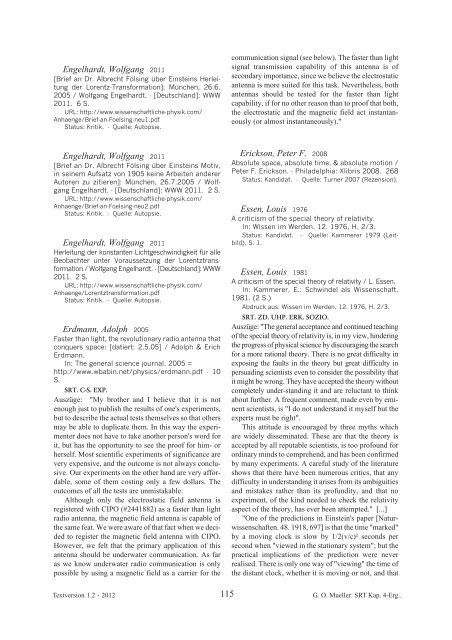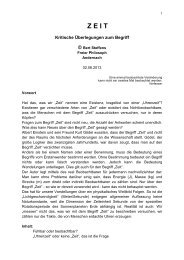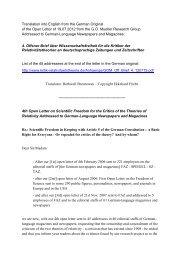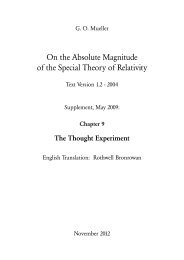2394 weitere kritische Veröffentlichungen - Kritische Stimmen zur ...
2394 weitere kritische Veröffentlichungen - Kritische Stimmen zur ...
2394 weitere kritische Veröffentlichungen - Kritische Stimmen zur ...
Sie wollen auch ein ePaper? Erhöhen Sie die Reichweite Ihrer Titel.
YUMPU macht aus Druck-PDFs automatisch weboptimierte ePaper, die Google liebt.
Engelhardt, Wolfgang 2011<br />
[Brief an Dr. Albrecht Fölsing über Einsteins Herleitung<br />
der Lorentz-Transformation]: München, 26.6.<br />
2005 / Wolfgang Engelhardt. - [Deutschland]: WWW<br />
2011. 6 S.<br />
URL: http://www.wissenschaftliche-physik.com/<br />
Anhaenge/Brief-an-Foelsing-neu1.pdf<br />
Status: Kritik. - Quelle: Autopsie.<br />
Engelhardt, Wolfgang 2011<br />
[Brief an Dr. Albrecht Fölsing über Einsteins Motiv,<br />
in seinem Aufsatz von 1905 keine Arbeiten anderer<br />
Autoren zu zitieren]: München, 26.7.2005 / Wolfgang<br />
Engelhardt. - [Deutschland]: WWW 2011. 2 S.<br />
URL: http://www.wissenschaftliche-physik.com/<br />
Anhaenge/Brief-an-Foelsing-neu2.pdf<br />
Status: Kritik. - Quelle: Autopsie.<br />
Engelhardt, Wolfgang 2011<br />
Herleitung der konstanten Lichtgeschwindigkeit für alle<br />
Beobachter unter Voraussetzung der Lorentztransformation<br />
/ Wolfgang Engelhardt. - [Deutschland]: WWW<br />
2011. 2 S.<br />
URL: http://www.wissenschaftliche-physik.com/<br />
Anhaenge/Lorentztransformation.pdf<br />
Status: Kritik. - Quelle: Autopsie.<br />
Erdmann, Adolph 2005<br />
Faster than light, the revolutionary radio antenna that<br />
conquers space: [datiert: 2.5.05] / Adolph & Erich<br />
Erdmann.<br />
In: The general science journal. 2005 =<br />
http://www.wbabin.net/physics/erdmann.pdf - 10<br />
S.<br />
SRT. C-S. EXP.<br />
Auszüge: "My brother and I believe that it is not<br />
enough just to publish the results of one's experiments,<br />
but to describe the actual tests themselves so that others<br />
may be able to duplicate them. In this way the experimenter<br />
does not have to take another person's word for<br />
it, but has the opportunity to see the proof for him- or<br />
herself. Most scientific experiments of significance are<br />
very expensive, and the outcome is not always conclusive.<br />
Our experiments on the other hand are very affordable,<br />
some of them costing only a few dollars. The<br />
outcomes of all the tests are unmistakable.<br />
Although only the electrostatic field antenna is<br />
registered with CIPO (#2441882) as a faster than light<br />
radio antenna, the magnetic field antenna is capable of<br />
the same feat. We were aware of that fact when we decided<br />
to register the magnetic field antenna with CIPO.<br />
However, we felt that the primary application of this<br />
antenna should be underwater communication. As far<br />
as we know underwater radio communication is only<br />
possible by using a magnetic field as a carrier for the<br />
communication signal (see below). The faster than light<br />
signal transmission capability of this antenna is of<br />
secondary importance, since we believe the electrostatic<br />
antenna is more suited for this task. Nevertheless, both<br />
antennas should be tested for the faster than light<br />
capability, if for no other reason than to proof that both,<br />
the electrostatic and the magnetic field act instantaneously<br />
(or almost instantaneously)."<br />
Erickson, Peter F. 2008<br />
Absolute space, absolute time, & absolute motion /<br />
Peter F. Erickson. - Philadelphia: Xlibris 2008. 268<br />
Status: Kandidat. - Quelle: Turner 2007 (Rezension).<br />
Essen, Louis 1976<br />
A criticism of the special theory of relativity.<br />
In: Wissen im Werden. 12. 1976, H. 2/3.<br />
Status: Kandidat. - Quelle: Kammerer 1979 (Leitbild),<br />
S. 1.<br />
Essen, Louis 1981<br />
A criticism of the special theory of relativity / L. Essen.<br />
In: Kammerer, E.: Schwindel als Wissenschaft.<br />
1981. (2 S.)<br />
Abdruck aus: Wissen im Werden. 12. 1976, H. 2/3.<br />
SRT. ZD. UHP. ERK. SOZIO.<br />
Auszüge: "The general acceptance and continued teaching<br />
of the special theory of relativity is, in my view, hindering<br />
the progress of physical science by discouraging the search<br />
for a more rational theory. There is no great difficulty in<br />
exposing the faults in the theory but great difficulty in<br />
persuading scientists even to consider the possibility that<br />
it might be wrong. They have accepted the theory without<br />
completely under-standing it and are reluctant to think<br />
about further. A frequent comment, made even by eminent<br />
scientists, is "I do not understand it myself but the<br />
experts must be right".<br />
This attitude is encouraged by three myths which<br />
are widely disseminated. These are that the theory is<br />
accepted by all reputable scientists, is too profound for<br />
ordinary minds to comprehend, and has been confirmed<br />
by many experiments. A careful study of the literature<br />
shows that there have been numerous critics, that any<br />
difficulty in understanding it arises from its ambiguities<br />
and mistakes rather than its profundity, and that no<br />
experiment, of the kind needed to check the relativity<br />
aspect of the theory, has ever been attempted." [...]<br />
"One of the predictions in Einstein's paper [Naturwissenschaften.<br />
48. 1918, 697] is that the time "marked"<br />
by a moving clock is slow by 1/2(v/c)² seconds per<br />
second when "viewed in the stationary system"; but the<br />
practical implications of the prediction were never<br />
realised. There is only one way of "viewing" the time of<br />
the distant clock, whether it is moving or not, and that<br />
Textversion 1.2 - 2012 115<br />
G. O. Mueller: SRT Kap. 4-Erg..





